Tobacco Usage Rates
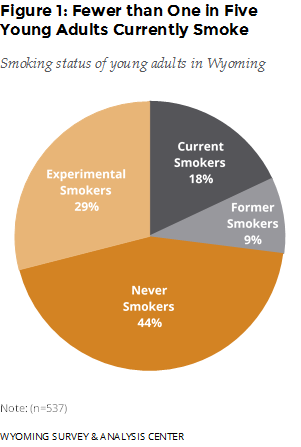 Cigarettes
Cigarettes
Using guidance from the Centers for Disease Control and Prevention (CDC, 2009), WYSAC defines current smokers as those who have smoked at least 100 cigarettes in their lifetime and who currently smoke cigarettes some days or every day. Former smokers are those who smoked at least 100 cigarettes in their lifetime but do not currently smoke. Experimental smokers are those who have tried cigarette smoking, even one or two puffs, but have smoked fewer than 100 cigarettes in their lifetime. Never smokers are those who have never tried smoking, not even a puff. In the YATS, 44% of young adults reported never smoking (Figure 1). The young adult smoking rate of 18% is comparable to the smoking rate of 19% in the Wyoming adult population (Wyoming Department of Health, 2016).
The average age that young adults reported first smoking part or all of a cigarette, even one or two puffs, was 16.5 years, below the legal limit of 18. Again, this is comparable to the Wyoming adult population (WYSAC, 2016).
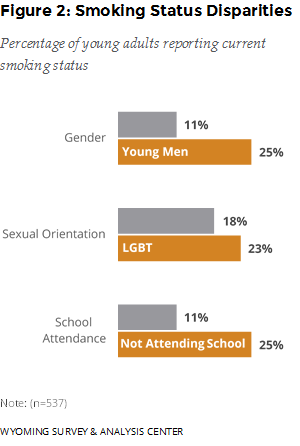 Disparities
Disparities
Three groups stood out as having high smoking rates: young men, those not attending school, and young adults who identified as LGBT (Figure 2). These findings are consistent with research that has shown that cigarette smoking is higher among individuals who are LGBT and among those who have obtained less than a college degree (CDC, 2015).
The YATS found that young men are more likely to smoke in Wyoming, compared to young women. This differs from findings for adult men and women, which has traditionally been comparable (WYSAC, 2016). However, other evidence shows that nationally, men differ from women in their smoking behaviors (National Institute on Drug Abuse, 2012; CDC, 2016) and young men may be less responsive to tobacco control strategies than young women (Ellis, Perl, Davis, & Vichinsky, 2008).
In the United States, cigarette smoking is more common among people serving in the military than among civilians. In 2011, 24% of active-duty military personnel reported current cigarette smoking compared to 19% of civilians (Barlas, Higgins, Pflieger, & Diecker, 2013). Although the sample of military personnel in the YATS was too small to run a significance test, the frequencies show that the smoking rate among military personnel (55%) appeared to be higher than non-military (17%).
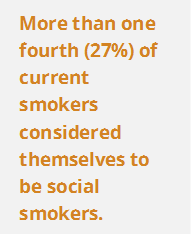 Smoking Status and Self-Labeling
Smoking Status and Self-Labeling
To test the differences between researchers’ definitions of cigarette smoking status and how young adults label themselves, including the idea of self-labeling as a social smoker, WYSAC asked young adults if they consider themselves to be a smoker, social smoker, ex-smoker, nonsmoker, or something else. More than one fourth (27%) of current smokers considered themselves to be social smokers. This finding could inform marketing and education efforts, which may be more effective if they were tailored to young adult “social smokers” as well as “smokers.”
Electronic Nicotine Delivery Systems (ENDS)
The YATS found that 47% of young adults reported trying e-cigarettes, electronic, or vapor cigarettes with nicotine at least once in their lifetime. Current cigarette smokers were significantly more likely to have tried ENDS than former, experimental, or never smokers (Figure 3).
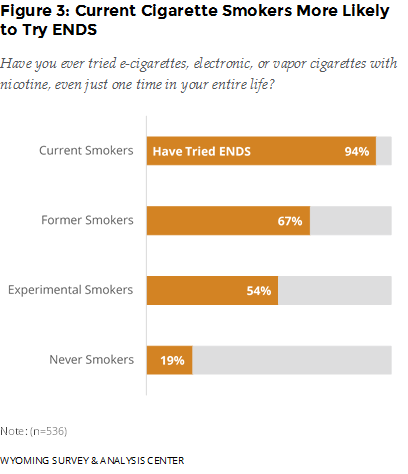
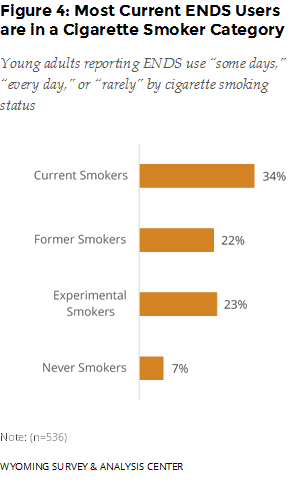
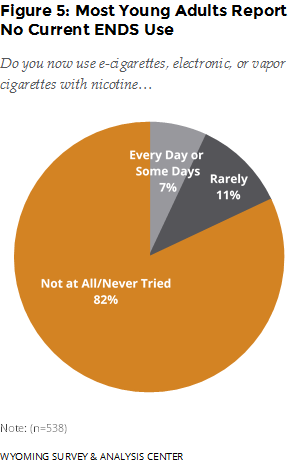 Young men (58%) were significantly more likely to have tried ENDS than young women (35%). Young adults identifying as Hispanic (63%) were significantly more likely to have tried ENDS than non-Hispanic young adults (45%).
Young men (58%) were significantly more likely to have tried ENDS than young women (35%). Young adults identifying as Hispanic (63%) were significantly more likely to have tried ENDS than non-Hispanic young adults (45%).
The majority (82%) of young adults in Wyoming reported having never tried ENDS or not currently using them, while 7% reported using them every day or some days (Figure 5). Significantly more young men reported using ENDS every day or some days (12%), compared to young women (3%).
Young adults who have smoked cigarettes were significantly more likely to report current ENDS use (every day, some days, or rarely; Figure 4). Former cigarette smokers (17%)
reported
using ENDS every day more frequently than current cigarette smokers (6%) and experimental cigarette smokers (2%).
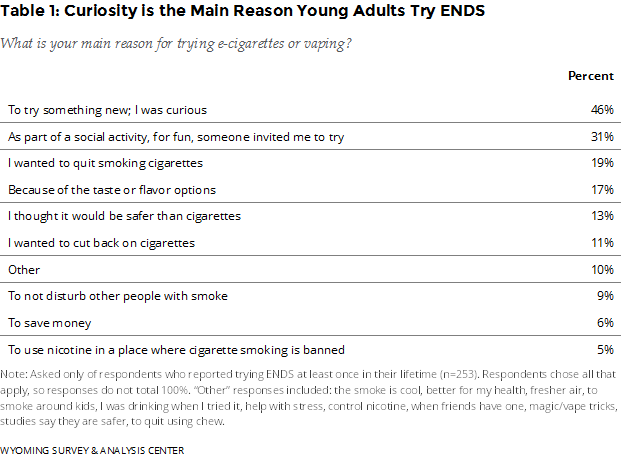
When asked about the main reason(s) for trying ENDS, almost half of Wyoming young adults (46%) said to try something new; I was curious. Another 31% said they tried ENDS as part of a social activity, for fun, someone invited me to try it (Table 1).

